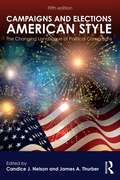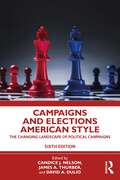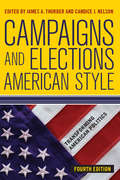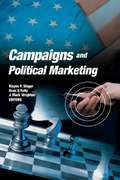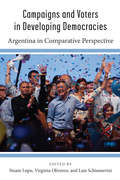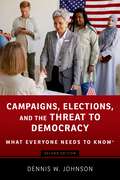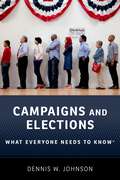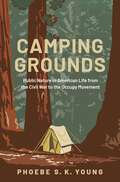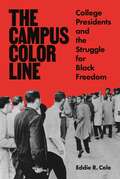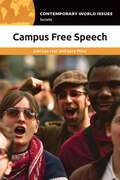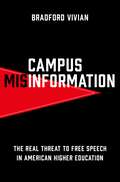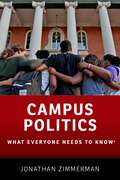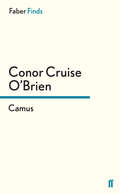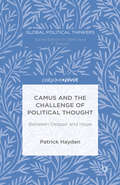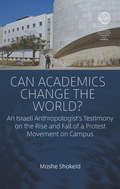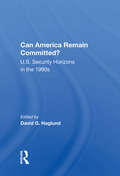- Table View
- List View
Campaigns and Elections American Style: The Changing Landscape of Political Campaigns
by Candice J. Nelson James A. ThurberFollowing one of the most contentious and surprising elections in US history, the new edition of this classic text demonstrates unequivocally: Campaigns matter. With new and revised chapters throughout, Campaigns and Elections American Style provides a real education in contemporary campaign politics. In the fifth edition, academics and campaign professionals explain how Trump won the presidency, comparing his sometimes novel tactics with tried and true strategies including how campaign themes and strategies are developed and communicated, the changes in campaign tactics as a result of changing technology, new techniques to target and mobilize voters, the evolving landscape of campaign finance and election laws, and the increasing diversity of the role of media in elections. Offering a unique and careful mix of Democrat and Republican, academic and practitioner, and male and female campaign perspectives, this volume scrutinizes national and local-level campaigns with a special focus on the 2016 presidential and congressional elections and what those elections might tell us about 2018 and 2020. Students, citizens, candidates, and campaign managers will learn not only how to win elections but also why it is imperative to do so in an ethical way. Perfect for a variety of courses in American government, this book is essential reading for political junkies of any stripe and serious students of campaigns and elections. Highlights of the Fifth Edition Covers the 2016 elections with an eye to 2018 and 2020. Explains how Trump won the presidency, the changes in campaign tactics as a result of changing technology, new techniques to target and mobilize voters, the evolving landscape of campaign finance and election laws, and the increasing diversity of the role of media. Includes a new part structure and the addition of part introductions to help students contextualize the major issues and trends in campaigns and elections.
Campaigns and Elections American Style: The Changing Landscape of Political Campaigns
by Candice J. Nelson James A. ThurberFollowing one of the most contentious and surprising elections in US history, the new edition of this classic text demonstrates unequivocally: Campaigns matter. With new and revised chapters throughout, Campaigns and Elections American Style provides a real education in contemporary campaign politics. In the fifth edition, academics and campaign professionals explain how Trump won the presidency, comparing his sometimes novel tactics with tried and true strategies including how campaign themes and strategies are developed and communicated, the changes in campaign tactics as a result of changing technology, new techniques to target and mobilize voters, the evolving landscape of campaign finance and election laws, and the increasing diversity of the role of media in elections. Offering a unique and careful mix of Democrat and Republican, academic and practitioner, and male and female campaign perspectives, this volume scrutinizes national and local-level campaigns with a special focus on the 2016 presidential and congressional elections and what those elections might tell us about 2018 and 2020. Students, citizens, candidates, and campaign managers will learn not only how to win elections but also why it is imperative to do so in an ethical way. Perfect for a variety of courses in American government, this book is essential reading for political junkies of any stripe and serious students of campaigns and elections. Highlights of the Fifth Edition Covers the 2016 elections with an eye to 2018 and 2020. Explains how Trump won the presidency, the changes in campaign tactics as a result of changing technology, new techniques to target and mobilize voters, the evolving landscape of campaign finance and election laws, and the increasing diversity of the role of media. Includes a new part structure and the addition of part introductions to help students contextualize the major issues and trends in campaigns and elections.
Campaigns and Elections American Style: The Changing Landscape of Political Campaigns
by Candice J. Nelson James A. Thurber David A. DulioWith new and revised chapters throughout, the sixth edition of Campaigns and Elections American Style allows academics and campaign professionals the chance to explain how the COVID-19 pandemic, 2020 general election, and 2022 midterm election upended the campaign process and changed the landscape of political campaigns forever. Offering a unique and careful mix of Democrat and Republican, academic and practitioner, and male and female campaign perspectives, this volume scrutinizes national and local-level campaigns. Students, citizens, candidates, and campaign managers learn not only how to win elections but also why it is imperative to do so in a safe and ethical way. Perfect for a variety of courses in American government, this book is especially valuable to schools of campaign management and campaign professionals working at every level from the local to the global. Highlights of the Sixth Edition Covers the 2020 and 2022 elections with an eye to 2024. Examines changes to the campaign process as a result of COVID-19 and puts them in context with campaign traditions over time. Includes a new organization that moves campaign finance up front to emphasize the centrality of fundraising to successful campaigns. Offers more data to inform campaign planning and management, especially related to key topics such as the change in news media coverage, the growth and use of social media, the use of "big data" in campaigns, and changes in field and voting rules and policies.
Campaigns and Elections American Style: The Changing Landscape of Political Campaigns
by Candice J. Nelson James A. Thurber David A. DulioWith new and revised chapters throughout, the sixth edition of Campaigns and Elections American Style allows academics and campaign professionals the chance to explain how the COVID-19 pandemic, 2020 general election, and 2022 midterm election upended the campaign process and changed the landscape of political campaigns forever. Offering a unique and careful mix of Democrat and Republican, academic and practitioner, and male and female campaign perspectives, this volume scrutinizes national and local-level campaigns. Students, citizens, candidates, and campaign managers learn not only how to win elections but also why it is imperative to do so in a safe and ethical way. Perfect for a variety of courses in American government, this book is especially valuable to schools of campaign management and campaign professionals working at every level from the local to the global. Highlights of the Sixth Edition Covers the 2020 and 2022 elections with an eye to 2024. Examines changes to the campaign process as a result of COVID-19 and puts them in context with campaign traditions over time. Includes a new organization that moves campaign finance up front to emphasize the centrality of fundraising to successful campaigns. Offers more data to inform campaign planning and management, especially related to key topics such as the change in news media coverage, the growth and use of social media, the use of "big data" in campaigns, and changes in field and voting rules and policies.
Campaigns and Elections American Style: Fourth Edition
by James A. ThurberUnderstanding the dynamics and transformation of American government.
Campaigns and Elections American Style (Transforming American Politics (4th Edition))
by James A. Thurber Candice J. NelsonWith new and revised essays throughout, Campaigns and Elections American Style provides a real education in practical campaign politics. In the fourth edition, academics and campaign professionals explain how campaign themes and strategies are developed and communicated, the changes in campaign tactics as a result of changing technology, new techniques to target and mobilize voters, the evolving landscape of campaign finance and election laws, and the increasing diversity of the role of media in elections. Offering a unique and careful mix of Democrat and Republican, academic and practitioner, and male and female campaign perspectives, this volume scrutinizes national and local-level campaigns with special focus on the 2012 presidential and congressional elections.Students, citizens, candidates, and campaign managers will learn not only how to win elections but also why it is imperative to do so in an ethical way. Perfect for a variety of courses in American government, this book is essential reading for political junkies of any stripe and serious students of campaigns and elections.
Campaigns and Political Marketing
by Wayne Steger Sean Kelly Mark WrightonUnderstand the theoretical-and practical-aspects of political marketing!Over the past few years political marketing strategies have been refined with the help of new findings in political science research. Campaigns and Political Marketing clearly discusses the most recent political science research studies and theories that political activists and professionals can apply to effectively campaign for an issue or candidate. This text is an invaluable compilation of research, theory, and practical application from political science experts across the country that guides readers through the complexities of everyday political marketing and campaigning. Readers get the critical knowledge needed on how to best affect public viewpoints and gain the strongest advantage over the opposition.Campaigns and Political Marketing is packed with information and insights every political activist will find useful. It coherently explains the real world of campaign politics and elections, presenting the everyday issues that political consultants face in the field, all made easily understandable even to the novice. This scholarly examination provides lessons that can be effectively applied to just about any situation. Political crises and scandals are discussed in detail, with research and historical studies that illuminate practical ways to deal with any problem. The book is extensively referenced and uses graphs and charts to clearly explain research findings.Campaigns and Political Marketing answers these tough questions: What is the role of professional campaign consultants-and their value? How have the past four presidential elections revised the state presidential vote forecasting equation? How does interest groups&’ resource distribution differ from resource allocation decisions made by candidates&’ organizations and the national political parties? How does congressional campaign candidate scheduling differ from legislative candidate scheduling? How effective are attack messages in generating media coverage early in a campaign? How do political professionals define campaign crises? What are the differences in public reaction when a candidate from one or the other of the two major parties is in a scandal? How is public opinion affected when tragedy strikes a political candidate?Campaigns and Political Marketing is stimulating, idea-generating reading that is perfect for educators and students in marketing, communications, and political science; practitioners in campaigns and marketing; and political activists of all types.
Campaigns and Political Marketing
by Wayne Steger Sean Kelly Mark WrightonUnderstand the theoretical-and practical-aspects of political marketing!Over the past few years political marketing strategies have been refined with the help of new findings in political science research. Campaigns and Political Marketing clearly discusses the most recent political science research studies and theories that political activists and professionals can apply to effectively campaign for an issue or candidate. This text is an invaluable compilation of research, theory, and practical application from political science experts across the country that guides readers through the complexities of everyday political marketing and campaigning. Readers get the critical knowledge needed on how to best affect public viewpoints and gain the strongest advantage over the opposition.Campaigns and Political Marketing is packed with information and insights every political activist will find useful. It coherently explains the real world of campaign politics and elections, presenting the everyday issues that political consultants face in the field, all made easily understandable even to the novice. This scholarly examination provides lessons that can be effectively applied to just about any situation. Political crises and scandals are discussed in detail, with research and historical studies that illuminate practical ways to deal with any problem. The book is extensively referenced and uses graphs and charts to clearly explain research findings.Campaigns and Political Marketing answers these tough questions: What is the role of professional campaign consultants-and their value? How have the past four presidential elections revised the state presidential vote forecasting equation? How does interest groups&’ resource distribution differ from resource allocation decisions made by candidates&’ organizations and the national political parties? How does congressional campaign candidate scheduling differ from legislative candidate scheduling? How effective are attack messages in generating media coverage early in a campaign? How do political professionals define campaign crises? What are the differences in public reaction when a candidate from one or the other of the two major parties is in a scandal? How is public opinion affected when tragedy strikes a political candidate?Campaigns and Political Marketing is stimulating, idea-generating reading that is perfect for educators and students in marketing, communications, and political science; practitioners in campaigns and marketing; and political activists of all types.
Campaigns and Voters in Developing Democracies: Argentina in Comparative Perspective (Weiser Center for Emerging Democracies)
by Noam Lupu Virginia Oliveros Luis SchiumeriniVoting behavior is informed by the experience of advanced democracies, yet the electoral context in developing democracies is significantly different. Civil society is often weak, poverty and inequality high, political parties ephemeral and attachments to them weak, corruption rampant, and clientelism widespread. Voting decisions in developing democracies follow similar logics to those in advanced democracies in that voters base their choices on group affiliation, issue positions, valence considerations, and campaign persuasion. Yet developing democracies differ in the weight citizens assign to these considerations. Where few social identity groups are politically salient and partisan attachments are sparse, voters may place more weight on issue voting. Where issues are largely absent from political discourse, valence considerations and campaign effects play a larger role. Campaigns and Voters in Developing Democracies develops a theoretical framework to specify why voter behavior differs across contexts.
Campaigns, Elections, and the Threat to Democracy: What Everyone Needs to Know® (WHAT EVERYONE NEEDS TO KNOW)
by Dennis W. JohnsonFrequent and fair elections, open to all, are fundamental elements of a democracy. The United States, through its local, state, and national contests, holds more elections, more often, than any other democracy in the world. But in recent years, there have been troubling signs that our system of campaigns and elections has become much more fragile and vulnerable. More specifically, in the past twenty years, campaigns have changed profoundly: social media and viral messaging compete with traditional media, races once considered local in nature have become nationalized, Supreme Court decisions on campaign finance law now encourage mega-donors, voters are more polarized, party affiliation has waned, and the middle ideological ground has given way to extremist language and voter rage. Twice in sixteen years we have seen winning presidential candidates gaining fewer popular votes than their opponents. The fundamental right of every citizen to vote has been impeded by state legislatures demanding tighter access, more identification, and accusations of voter fraud. And we have faced the real threat of foreign influence in our national elections. This new edition of Campaigns, Elections, and the Threat to Democracy: What Everyone Needs to Know® offers the most up-to-date examination of campaigns, elections, and future threats to voting and democracy. It addresses the 2020 US presidential election, the "Stop the Steal" movement, election interference and cyber threats to voting, voting by mail (and the backlash against it), voting reforms and ranked-choice voting, and the Supreme Court 2019 ruling on gerrymandering. It will also include new data on voter participation, voter fraud, reapportionment post-2020 census, party polarization, campaign finance, and more. Given the fragility of our election process, what are the threats to a healthy American democracy? Do the candidates with the most money always win? This is not simply a book on how campaigns are run, but why campaigns and elections are integral components of American democracy and how those fundamental elements may be vulnerable to misuse.
Campaigns, Elections, and the Threat to Democracy: What Everyone Needs to Know® (WHAT EVERYONE NEEDS TO KNOW)
by Dennis W. JohnsonFrequent and fair elections, open to all, are fundamental elements of a democracy. The United States, through its local, state, and national contests, holds more elections, more often, than any other democracy in the world. But in recent years, there have been troubling signs that our system of campaigns and elections has become much more fragile and vulnerable. More specifically, in the past twenty years, campaigns have changed profoundly: social media and viral messaging compete with traditional media, races once considered local in nature have become nationalized, Supreme Court decisions on campaign finance law now encourage mega-donors, voters are more polarized, party affiliation has waned, and the middle ideological ground has given way to extremist language and voter rage. Twice in sixteen years we have seen winning presidential candidates gaining fewer popular votes than their opponents. The fundamental right of every citizen to vote has been impeded by state legislatures demanding tighter access, more identification, and accusations of voter fraud. And we have faced the real threat of foreign influence in our national elections. This new edition of Campaigns, Elections, and the Threat to Democracy: What Everyone Needs to Know® offers the most up-to-date examination of campaigns, elections, and future threats to voting and democracy. It addresses the 2020 US presidential election, the "Stop the Steal" movement, election interference and cyber threats to voting, voting by mail (and the backlash against it), voting reforms and ranked-choice voting, and the Supreme Court 2019 ruling on gerrymandering. It will also include new data on voter participation, voter fraud, reapportionment post-2020 census, party polarization, campaign finance, and more. Given the fragility of our election process, what are the threats to a healthy American democracy? Do the candidates with the most money always win? This is not simply a book on how campaigns are run, but why campaigns and elections are integral components of American democracy and how those fundamental elements may be vulnerable to misuse.
CAMPAIGNS & ELECTIONS WENK C: What Everyone Needs to Know® (What Everyone Needs to Know)
by Dennis W. JohnsonFrequent and fair elections, open to all, are fundamental elements of a democracy. The United States, through its local, state, and national contests, holds more elections, more often, than any other democracy in the world. But in recent years, there have been troubling signs that our system of campaigns and elections has become much more fragile than we had previously thought. More specifically, in the past twenty years, campaigns have changed profoundly: social media and viral messaging compete with traditional media, races once considered local in nature have become nationalized, Supreme Court decisions on campaign finance law now encourage mega-donors, voters are more polarized, party affiliation has waned, and the middle ideological ground has given way to extremist language and voter rage. Twice in sixteen years we have seen winning presidential candidates gaining fewer popular votes than their opponents. The fundamental right of every citizen to vote has been impeded by state legislatures demanding tighter access, more identification, and accusations of voter fraud. And we have faced the real threat of foreign influence in our national elections. This book offers the most up-to-date examination of campaigns and elections, including the challenges and opportunities they present. It addresses fundamental questions about who votes in American elections, how legislative districts are reapportioned and why it matters, the realities of voter fraud, the pros and cons of reforming the Electoral College, the impact of dark money on campaigns, and the role of political consultants and specialists, among other topics. Given the fragility of our election process, what are the threats to a healthy American democracy? Do the candidates with the most money always win? This is not simply a book on how campaigns are run, but why campaigns and elections are integral components of American democracy and how those fundamental elements may be vulnerable to misuse.
Camping Grounds: Public Nature in American Life from the Civil War to the Occupy Movement
by Phoebe S.K. YoungAn exploration of the hidden history of camping in American life that connects a familiar recreational pastime to camps for functional needs and political purposes. Camping appears to be a simple proposition, a time-honored way of getting away from it all. Pack up the car and hit the road in search of a shady spot in the great outdoors. For a modest fee, reserve the basic infrastructure--a picnic table, a parking spot, and a place to build a fire. Pitch the tent and unroll the sleeping bags. Sit under the stars with friends or family and roast some marshmallows. This book reveals that, for all its appeal, the simplicity of camping is deceptive, its history and meanings far from obvious. Why do some Americans find pleasure in sleeping outside, particularly when so many others, past and present, have had to do so for reasons other than recreation? Never only a vacation choice, camping has been something people do out of dire necessity and as a tactic of political protest. Yet the dominant interpretation of camping as a modern recreational ideal has obscured the connections to these other roles. A closer look at the history of camping since the Civil War reveals a deeper significance of this American tradition and its links to core beliefs about nature and national belonging. Camping Grounds rediscovers unexpected and interwoven histories of sleeping outside. It uses extensive research to trace surprising links between veterans, tramps, John Muir, African American freedpeople, Indian communities, and early leisure campers in the nineteenth century; tin-can tourists, federal campground designers, Depression-era transients, family campers, backpacking enthusiasts, and political activists in the twentieth century; and the crisis of the unsheltered and the tent-based Occupy Movement in the twenty-first. These entwined stories show how Americans camp to claim a place in the American republic and why the outdoors is critical to how we relate to nature, the nation, and each other.
Camping Grounds: Public Nature in American Life from the Civil War to the Occupy Movement
by Phoebe S.K. YoungAn exploration of the hidden history of camping in American life that connects a familiar recreational pastime to camps for functional needs and political purposes. Camping appears to be a simple proposition, a time-honored way of getting away from it all. Pack up the car and hit the road in search of a shady spot in the great outdoors. For a modest fee, reserve the basic infrastructure--a picnic table, a parking spot, and a place to build a fire. Pitch the tent and unroll the sleeping bags. Sit under the stars with friends or family and roast some marshmallows. This book reveals that, for all its appeal, the simplicity of camping is deceptive, its history and meanings far from obvious. Why do some Americans find pleasure in sleeping outside, particularly when so many others, past and present, have had to do so for reasons other than recreation? Never only a vacation choice, camping has been something people do out of dire necessity and as a tactic of political protest. Yet the dominant interpretation of camping as a modern recreational ideal has obscured the connections to these other roles. A closer look at the history of camping since the Civil War reveals a deeper significance of this American tradition and its links to core beliefs about nature and national belonging. Camping Grounds rediscovers unexpected and interwoven histories of sleeping outside. It uses extensive research to trace surprising links between veterans, tramps, John Muir, African American freedpeople, Indian communities, and early leisure campers in the nineteenth century; tin-can tourists, federal campground designers, Depression-era transients, family campers, backpacking enthusiasts, and political activists in the twentieth century; and the crisis of the unsheltered and the tent-based Occupy Movement in the twenty-first. These entwined stories show how Americans camp to claim a place in the American republic and why the outdoors is critical to how we relate to nature, the nation, and each other.
The Campus Color Line: College Presidents and the Struggle for Black Freedom
by Eddie R. Cole"A stunning and ambitious origins story."—Ibram X. Kendi, National Book Award–winning and #1 New York Times–bestselling authorThe remarkable history of how college presidents shaped the struggle for racial equalitySome of America’s most pressing civil rights issues—desegregation, equal educational and employment opportunities, housing discrimination, and free speech—have been closely intertwined with higher education institutions. Although it is commonly known that college students and other activists, as well as politicians, actively participated in the fight for and against civil rights in the middle decades of the twentieth century, historical accounts have not adequately focused on the roles that the nation’s college presidents played in the debates concerning racism. Based on archival research conducted at a range of colleges and universities across the United States, The Campus Color Line sheds light on the important place of college presidents in the struggle for racial parity.Focusing on the period between 1948 and 1968, Eddie Cole shows how college presidents, during a time of violence and unrest, strategically, yet often silently, initiated and shaped racial policies and practices inside and outside of the educational sphere. With courage and hope, as well as malice and cruelty, college presidents positioned themselves—sometimes precariously—amid conflicting interests and demands. Black college presidents challenged racist policies as their students demonstrated in the streets against segregation, while presidents of major universities lobbied for urban renewal programs that displaced Black communities near campus. Some presidents amended campus speech practices to accommodate white supremacist speakers, even as other academic leaders developed the nation’s first affirmative action programs in higher education.The Campus Color Line illuminates how the legacy of academic leaders’ actions continues to influence the unfinished struggle for Black freedom and racial equity in education and beyond.
Campus Free Speech: A Reference Handbook (Contemporary World Issues)
by Lori Cox Han Jerry PriceComprehensive and accessible, this one-stop resource examines the history, development, and present state of free speech issues on college campuses, including a range of political perspectives and viewpoints. It explains such concepts and forces as academic freedom, intellectual benefits of open debate, using speech as a weapon of hate and harassment, and the history of campus social protest. It also presents a broad survey of the arguments and rhetoric-as well as actual record-of America's two major parties on campus free speech and academic freedom issues. Other focuses of coverage include major laws and commonly employed college and university policies governing free speech and civil liberties for students, faculty, and other employees on campuses and classrooms across the country.This book accomplishes all of the above via a combination of informative resources-tables, primary documents, biographical profiles, illuminating essays, a chronology, and more-that are the trademark of the Contemporary World Issues series.
Campus Free Speech: A Reference Handbook (Contemporary World Issues)
by Lori Cox Han Jerry PriceComprehensive and accessible, this one-stop resource examines the history, development, and present state of free speech issues on college campuses, including a range of political perspectives and viewpoints. It explains such concepts and forces as academic freedom, intellectual benefits of open debate, using speech as a weapon of hate and harassment, and the history of campus social protest. It also presents a broad survey of the arguments and rhetoric-as well as actual record-of America's two major parties on campus free speech and academic freedom issues. Other focuses of coverage include major laws and commonly employed college and university policies governing free speech and civil liberties for students, faculty, and other employees on campuses and classrooms across the country.This book accomplishes all of the above via a combination of informative resources-tables, primary documents, biographical profiles, illuminating essays, a chronology, and more-that are the trademark of the Contemporary World Issues series.
Campus Misinformation: The Real Threat to Free Speech in American Higher Education
by Bradford VivianAn incisive examination of how pundits and politicians manufactured the campus free speech crisis--and created a genuine challenge to academic freedom in the process. If we listen to the politicians and pundits, college campuses have become fiercely ideological spaces where students unthinkingly endorse a liberal orthodoxy and forcibly silence anyone who dares to disagree. These commentators lament the demise of free speech and academic freedom. But what is really happening on college campuses? Campus Misinformation shows how misinformation about colleges and universities has proliferated in recent years, with potentially dangerous results. Popular but highly misleading claims about a so-called free speech crisis and a lack of intellectual diversity on college campuses emerged in the mid-2010s and continue to shape public discourse about higher education across party lines. Such disingenuous claims impede constructive deliberation about higher learning while normalizing suspect ideas about First Amendment freedoms and democratic participation. Taking a non-partisan approach, Bradford Vivian argues that reporting on campus culture has grossly exaggerated the importance and representativeness of a small number of isolated events; misleadingly advocated for an artificial parity between liberals and conservatives as true viewpoint diversity; mischaracterized the use of trigger warnings and safe spaces; and purposefully confused critique and protest with censorship and "cancel culture." Organizations and think tanks generate pseudoscientific data to support this discourse, then advocate for free speech in highly specific ways that actually limit speech in general. In the name of free speech and viewpoint diversity, we now see restrictions on the right to protest and laws banning certain books, theories, and subjects from schools. By deconstructing the political and rhetorical development of the free speech crisis, Vivian not only provides a powerful corrective to contemporary views of higher education, but provides a blueprint for readers to identify and challenge misleading language--and to understand the true threats to our freedoms.
Campus Misinformation: The Real Threat to Free Speech in American Higher Education
by Bradford VivianAn incisive examination of how pundits and politicians manufactured the campus free speech crisis--and created a genuine challenge to academic freedom in the process. If we listen to the politicians and pundits, college campuses have become fiercely ideological spaces where students unthinkingly endorse a liberal orthodoxy and forcibly silence anyone who dares to disagree. These commentators lament the demise of free speech and academic freedom. But what is really happening on college campuses? Campus Misinformation shows how misinformation about colleges and universities has proliferated in recent years, with potentially dangerous results. Popular but highly misleading claims about a so-called free speech crisis and a lack of intellectual diversity on college campuses emerged in the mid-2010s and continue to shape public discourse about higher education across party lines. Such disingenuous claims impede constructive deliberation about higher learning while normalizing suspect ideas about First Amendment freedoms and democratic participation. Taking a non-partisan approach, Bradford Vivian argues that reporting on campus culture has grossly exaggerated the importance and representativeness of a small number of isolated events; misleadingly advocated for an artificial parity between liberals and conservatives as true viewpoint diversity; mischaracterized the use of trigger warnings and safe spaces; and purposefully confused critique and protest with censorship and "cancel culture." Organizations and think tanks generate pseudoscientific data to support this discourse, then advocate for free speech in highly specific ways that actually limit speech in general. In the name of free speech and viewpoint diversity, we now see restrictions on the right to protest and laws banning certain books, theories, and subjects from schools. By deconstructing the political and rhetorical development of the free speech crisis, Vivian not only provides a powerful corrective to contemporary views of higher education, but provides a blueprint for readers to identify and challenge misleading language--and to understand the true threats to our freedoms.
Campus Politics: What Everyone Needs to Know® (What Everyone Needs To Know®)
by Jonathan ZimmermanUniversities are usually considered bastions of the free exchange of ideas, but a recent tide of demonstrations across college campuses has called this belief into question, and with serious consequences. Such a wave of protests hasn't been seen since the campus free speech demonstrations of the 1960s, yet this time it is the political Left, rather than the political Right, calling for restrictions on campus speech and freedom. And, as Jonathan Zimmerman suggests, recent campus controversies have pitted free speech against social justice ideals. The language of trauma--and, more generally, of psychology--has come to dominate campus politics, marking another important departure from prior eras. This trend reflects an increased awareness of mental health in American society writ large. But it has also tended to dampen exchange and discussion on our campuses, where faculty and students self-censor for fear of insulting or offending someone else. Or they attack each other in periodic bursts of invective, which run counter to the "civility" promised by new speech and conduct codes. In Campus Politics: What Everyone Needs to Know®, Jonathan Zimmerman breaks down the dynamics of what is actually driving this recent wave of discontent. After setting recent events in the context of the last half-century of free speech campus movements, Zimmerman looks at the political beliefs of the US professorate and students. He follows this with chapters on political correctness; debates over the contested curriculum; admissions, faculty hires, and affirmative action; policing students; academic freedom and censorship; in loco parentis administration; and the psychology behind demands for "trigger warnings" and "safe spaces." He concludes with the question of how to best balance the goals of social and racial justice with the commitment to free speech.
CAMPUS POLITICS WENK C: What Everyone Needs to Know® (What Everyone Needs To Know®)
by Jonathan ZimmermanUniversities are usually considered bastions of the free exchange of ideas, but a recent tide of demonstrations across college campuses has called this belief into question, and with serious consequences. Such a wave of protests hasn't been seen since the campus free speech demonstrations of the 1960s, yet this time it is the political Left, rather than the political Right, calling for restrictions on campus speech and freedom. And, as Jonathan Zimmerman suggests, recent campus controversies have pitted free speech against social justice ideals. The language of trauma--and, more generally, of psychology--has come to dominate campus politics, marking another important departure from prior eras. This trend reflects an increased awareness of mental health in American society writ large. But it has also tended to dampen exchange and discussion on our campuses, where faculty and students self-censor for fear of insulting or offending someone else. Or they attack each other in periodic bursts of invective, which run counter to the "civility" promised by new speech and conduct codes. In Campus Politics: What Everyone Needs to Know®, Jonathan Zimmerman breaks down the dynamics of what is actually driving this recent wave of discontent. After setting recent events in the context of the last half-century of free speech campus movements, Zimmerman looks at the political beliefs of the US professorate and students. He follows this with chapters on political correctness; debates over the contested curriculum; admissions, faculty hires, and affirmative action; policing students; academic freedom and censorship; in loco parentis administration; and the psychology behind demands for "trigger warnings" and "safe spaces." He concludes with the question of how to best balance the goals of social and racial justice with the commitment to free speech.
Camus
by Conor Cruise O'BrienEssential reading for old fans and new admirers of Albert Camus' classic quarantine novel THE PLAGUE - a new bestseller amidst the coronavirus pandemic.'Brilliant.' The Times'Joyous ... A unique critical talent.' TLSAlbert Camus is one of the most famous French writers of the twentieth century, a Nobel Laureate celebrated for his classic existentialist novel The Outsider and urgently relevant allegory of a pandemic, The Plague. But what about his controversial attitudes to race, especially his portrayal of Arabs versus Europeans, and French colonialism in Algeria?As provocative and brilliantly argued as it was in 1970, Conor Cruise O'Brien's Camus is a groundbreaking postcolonial critique which revolutionised how Camus was viewed by a new generation.
Camus and the Challenge of Political Thought: Between Despair and Hope (Global Political Thinkers)
by P. HaydenAlbert Camus was a formative artist, writer and public figure whose work defies conventional labels, and whose legacy is controversial but substantial. His distinctive contribution to modern ethical and political thought remains far from settled. Camus and the Challenge of Political Thought comprehensively yet concisely explores how Camus's compelling ideas of absurdity and rebellion emerged, how his complex political engagements and positions developed, and how his conception of an ethics of limits and measure retains a vital, contemporary resonance in an era of unsettling global politics. Drawing upon the full range of Camus's notebooks, novels, plays and philosophical essays, Hayden shows Camus to be an original political thinker of human dignity and freedom whose life and work sought to navigate between the twin dangers of idealistic optimism and nihilistic despair.
Can Academics Change the World?: An Israeli Anthropologist's Testimony on the Rise and Fall of a Protest Movement on Campus (EASA Series #39)
by Moshe ShokeidMoshe Shokeid narrates his experiences as a member of AD KAN (NO MORE), a protest movement of Israeli academics at Tel Aviv University, who fought against the Israeli occupation of Palestinian territories, founded during the first Palestinian Intifada (1987-1993). However, since the assassination of Prime Minister Rabin and the later obliteration of the Oslo accord, public manifestations of dissent on Israeli campuses have been remarkably mute. This chronicle of AD KAN is explored in view of the ongoing theoretical discourse on the role of the intellectual in society and is compared with other account of academic involvement in different countries during periods of acute political conflict.
Can America Remain Committed?: U.s. Security Horizons In The 1990s
by David G. HaglundThe twelve months that spanned the period between the early springtimes of 1991 and 1992 may well turn out to constitute the most important year for American foreign and security policy in half a century. Encasing the dawning of a new and different security era, like macabre parentheses, were two columns of black smoke-that of 1991 over the newly liberated Kuwait, and that of 1992 over the embattled district of South-Central Los Angeles. Within these acrid temporal brackets unfolded a set of developments of utmost significance for American foreign and security policy and for the very meaning of the country's external commitments.
